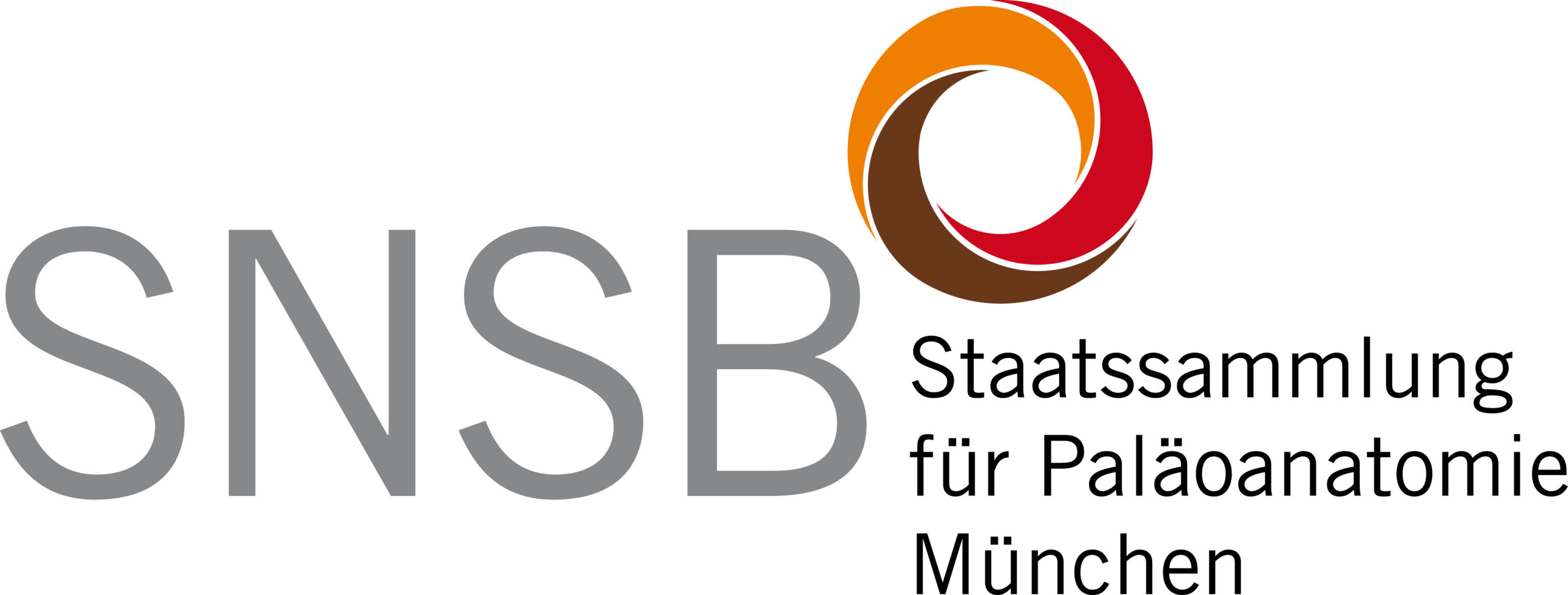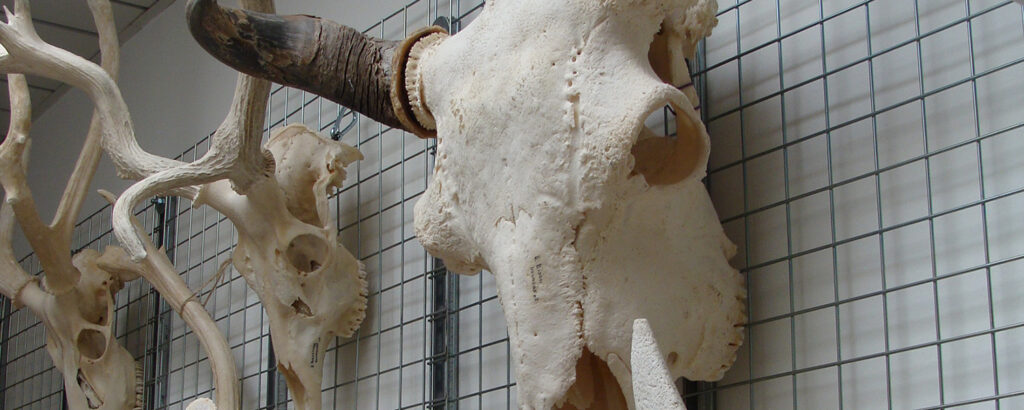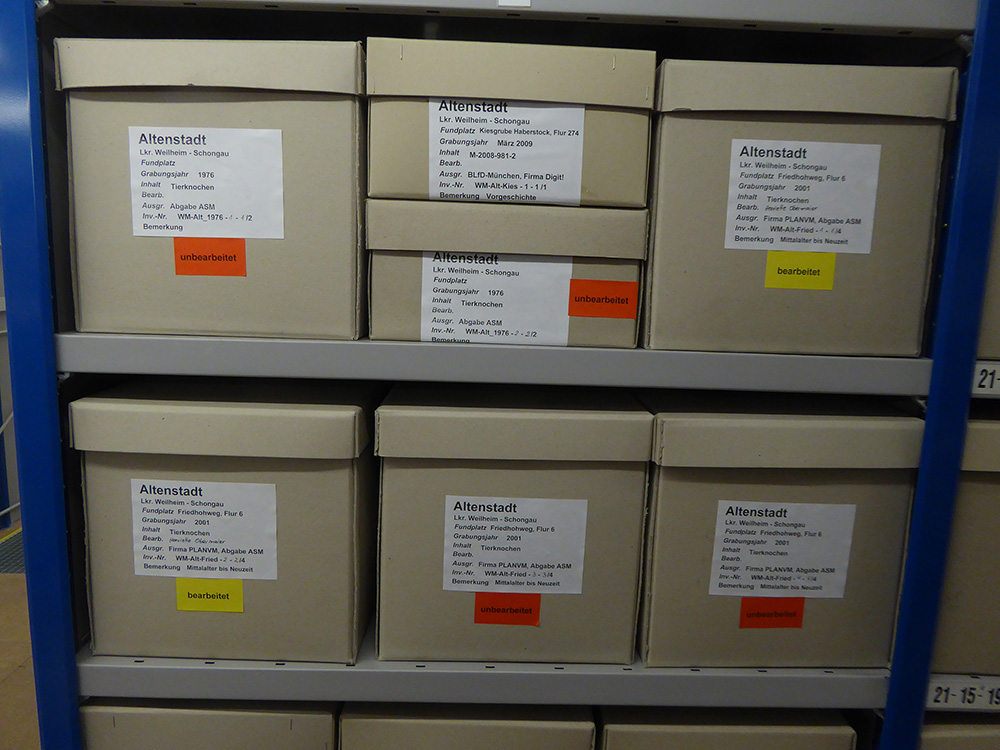History
The collections of the Department of Palaeoanatomy are relatively young in comparison to the other institutions of the SNSB. The “Institute for Palaeoanatomy, Domestication Research and History of Veterinary Medicine” was founded in 1965 as a result of the fusion of two departments within the Faculty of Veterinary Medicine at the Ludwig-Maximilians-University of Munich, namely “Palaeoanatomy” in the Institute of Animal Anatomy and “History of Veterinary Medicine” in the Institute of State Veterinary Medicine and History of Veterinary Medicine. Joachim Boessneck (*1925; †1991) directed the institute from its founding until his unexpected death. As early as the founding phase, he succeeded in bringing Angela von den Driesch (*1934; †2012) to the institute as an assistant. Boessneck and von den Driesch were pioneers of German and European archaeozoology who carried out basic research, processed vast amounts of archaeological material, and thus established the subject and gave it recognition in neighbouring disciplines in accordance with its importance for the cultural history of mankind. The extensive list of joint publications alone shows how fruitful this cooperation was. But also the considerable number of young scientists who were trained or completed internships at the Munich Institute speaks for itself.
After Boessneck’s death, von den Driesch was appointed professor to the chair and thereby became head of the institute. As one of the so-called ” minor subjects,” this was always considered superfluous. Thus, it is thanks to von den Driesch’s powers of persuasion that numerous institutions and respected scientists in Germany and abroad, as well as colleagues at the LMU, lobbied for the chair to be reassigned with the same title after her retirement in 1999. At the same time, von den Driesch succeeded in reaching an agreement with the university and the Bavarian Natural History Collections (SNSB) under its then director Prof. Dr. Heinz Schulz, so that the former university archaeozoological collections could be united with the Bavarian State Collection of Anthropology to form the Bavarian State Collection of Anthropology and Palaeoanatomy within the framework of the so-called Munich Model. As stipulated in the Munich model, the holder of the professorship acts in personal union as director of the corresponding State Collection. In 2000, Joris Peters was appointed to succeed Angela von den Driesch as professor and chair holder at the institute and thus also became the first director of the Department of Palaeoanatomy at the Bavarian State Collection of Anthropology and Palaeoanatomy.
The Palaeoanatomical Collection
In principle, the palaeoanatomical collection is composed of two parts, the collection of archaeological findings and the more recent comparative collection. In 1965, the latter consisted of only a few skeletons of common domestic animal species and a few wild animal species, as well as a few native bird specimens, so that in the early years other collections had to be sought out and the advice of colleagues (e.g., Prof. Lepiksaar in Gothenburg, Sweden) had to be consulted. For example, for the immensely important basic work on the differentiation of sheep and goats, which Boessneck had already worked out together with the colleagues H.-H. Müller and M. Teichert from Halle before the founding of the institute, the collection of reference skeletons in Munich would not have been at all sufficient. This work was therefore done on the extremely extensive collection of domestic animal skeletons of the Museum für Haustierkunde in Halle/Saale – at that time one of the rather rare cooperations across the Iron Curtain.
Thanks to the tireless collecting efforts of Boessneck and von den Driesch, as well as the assistance of numerous friends, students, and colleagues who supplied the institute’s taxidermists with fallen animals, accident victims, or animals from the students’ dissection practices, the inventory of the recent reference collection grew to over 13,800 specimens of vertebrates (mammals, birds, fish, reptiles, amphibians) by 1990. While Boessneck was particularly successful in expanding the bird collection, von den Driesch’s main focus lay in building up the fish skeleton collection. Today, the recent collection comprises more than 20,000 objects, mainly of Old World species. The collections of bird and fish skeletons are particularly extensive and therefore popular with researchers in archaeozoology, but also biology and palaeontology from all over the world.
However, spatial bottlenecks caused major problems since the founding of the institute. Initially, offices and collections were housed separately on the faculty’s main campus at the Englischer Garten and in a rented apartment in Franz-Josef-Str. The joining of offices, laboratories and a large part of the recent collection in Schellingstr. 10 in 1974 eased the workload to a certain extent. However, parts of the recent collection and especially the archaeological faunal remains remained placed in various basements of university buildings. Due to the lack of space, archaeological faunal remains had to be returned after processing. Neither with the move to a former loden factory in Feldmochinger Str. in the early 1990s nor with the move to Kaulbachstr. 37 in 2000 did the space situation improve significantly, as large parts of the collection still remained in various basement rooms of the university and were thus only accessible for processing to a limited extent. The great success came in 2009, when the Free State of Bavaria acquired vacant buildings in Poing and housed not only the depots of the Bavarian State Collection of Palaeontology and Historical Geology and the State Theater in Munich, but also the collection of archaeozoological finds and large parts of the recent collection. Since then, all archaeofaunal findings, on behalf of the Bavarian State Office for the Preservation of Monuments, have been housed in the State Collection – with the exception of collections that can be housed in suitable depots at municipal archaeological offices or universities.




